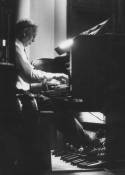
Gurdjieff International Review
Mr. Nyland and the Piano
by Terry Winter Owens
In the early 1960s, at the height of the “Turn On, Tune In, Drop Out,” LSD madness, Richard Alpert (now known as Ram Dass) and Ralph Metzner became interested in the ideas of Gurdjieff. Alpert and Metzner were two thirds of the Harvard trio of professors who championed LSD and were asked to leave the university. Metzner was at that time the editor of The Psychedelic Review. Alpert and Timothy Leary had formed the Castalia Foundation with headquarters in a mansion on a 2,500 acre estate in Millbrook, New York, made available to them, it is said, by the Hitchcock family.
Mr. Nyland was widely known in those days as one of the most authoritative students of Gurdjieff. Although Mr. Nyland always made it clear that he adamantly opposed all drug use, from marijuana to LSD, he wasn’t one to summarily dismiss a person because of drug use. Nyland was sympathetic to people who were interested in the Work and he was more apt to be accepting than judgmental. But most assuredly, the focus of his work with groups and with individuals was on pursuing the practical application of the Gurdjieff ideas in daily life, and not on drug rehabilitation.
And so it came about that Alpert and Metzner were allowed to join the Nyland groups which in those days met outside of the Gurdjieff Foundation. One day Alpert and Metzner approached Mr. Nyland with a gift offering from Timothy Leary: a Steinway concert grand piano. As is still the case, Steinway pianos are treasured by concert pianists and amateurs alike and, even in poor condition, are quite expensive. A Steinway grand was not a gift that one would easily turn down. Yet, instead of simply accepting this gift, Mr. Nyland asked me to go up to Millbrook and evaluate it “Why not just take it?” I asked, “particularly if they are willing to pay for shipping it to you.” He did not answer directly but asked me to go up to Millbrook and try out the piano. I have been known to go anywhere to try out a piano, so I agreed.
Because my husband had prior commitments, Mr. Nyland asked the composer/pianist David Greenberg to drive me to Millbrook and also give his opinion of the instrument. Two other people rounded out the delegation. Mr. Nyland warned us not to eat or drink anything that might be offered, no matter what! Stories were then au courant about refreshments being laced with LSD.
On the designated evening of our piano quest, nervous and curious, we set off, with Greenberg at the wheel. His driving was a preamble of what was to come: when he realized he had taken a wrong exit, he backed down the ramp onto the highway into the stream of traffic. This move was, in my opinion, a tad more dangerous than LSD, but we finally made it to Millbrook.
The mansion at Millbrook sat atop a gentle rise, preceded by a long unlit driveway that had been jack-hammered into rubble. Barriers had been placed at the foot of the driveway and several cars were parked there. Wishing for a flashlight or a guide, we got out of our car and stumbled up the dark driveway.
We knocked on the front door and were told that Tim Leary was expecting us and would we please wait until he was summoned. The house was dark (perhaps the electricity had been turned off?). In short order, Leary appeared and greeted us very warmly. He was quite charming and friendly, and we chatted a bit. He said that he would like to give us the cook’s tour. We politely declined protesting that it was a long drive back to the city, but he was insistent. He left, and soon a young woman came to show us around.
To say that the place looked like an opium den would deny its disarray and raunchiness. Yes, we had all seen apartments in the East Village with bare mattresses on the floor, huge candles melted into Salvador Dali shapes and people in various states of undress and dysfunctionality—but Millbrook was something else again. And, yes, we repeatedly turned down offers of refreshment. Finally, standing my ground and refusing to continue the tour, I explained that we had come explicitly to try out the piano. “Oh, the piano! Of course. It’s on the back porch.” The back porch?
There on the back porch was a disemboweled piano. The innards, the strings and the frame were leaning drunkenly against a wall on which clothes hangers, kitchen utensils, tools, screwdrivers, and the like were hung. Our guide picked up a tire wrench and ran it up and down the length of the strings. “We liberated the piano,” she said blissfully. “Where is the rest of the piano, the keyboard, the case, the action?” I asked stupidly. She did not answer but languidly ran a mop handle along the strings to demonstrate that I was being boringly conventional and obviously didn’t know the first thing about a piano’s potential. Other people appeared and joined in this concert-from-hell. We slipped away unnoticed.
Mr. Nyland did not seem surprised when we told him about the piano nor did he try to justify having us look into the mouth of a gift horse.
|
Copyright © 2000 Terry Winter Owens This webpage © 2000 Gurdjieff Electronic Publishing Featured: Fall 2000 Issue, Vol. IV (1) Revision: October 1, 2000 |